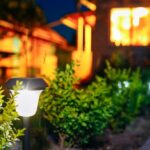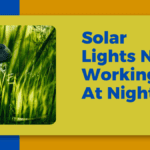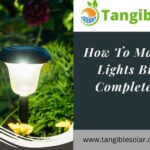How to Hard Wire Solar Lights? Effortlessly Illuminate Your Space
To hardwire solar lights, you must first connect the solar panel to the battery and then wire the lights to the battery in a step-by-step method. This allows the lights to run on solar energy rather than grid electricity. Hard-Wiring
You may have a cost-effective and environmentally friendly lighting option for your outdoor spaces by hardwiring solar lights. We will walk you through the process of hard-wiring solar lights to ensure the best performance and efficiency. So, let us begin the journey of harnessing the power of the sun for your outdoor lighting needs.
How to Clean Yellowed Plastic Solar Lights
Understanding Solar Light Hardwiring
This comprehensive guide will teach you the ins and outs of hard-wiring solar lights. Learn how to install and connect your solar lights properly for a dependable and efficient lighting option.
The Fundamentals of Hardwiring Solar Lights
- Installing solar lights via hard wiring is a common and efficient method of establishing your outdoor lighting system. You eliminate the need for batteries or solar panels by directly connecting the lights to a power source, assuring a steady and stable power supply. Here are a few crucial items to remember:
- Hard wiring: Hard wiring entails physically connecting the solar lights to an electrical circuit. This necessitates connecting the lights to a power source, such as your home’s electrical system or a separate solar power system.
- Electrical safety: It is critical to understand electrical safety before doing any hard wiring. If you are new to electrical work or are uncomfortable working with electricity, it is best to see a professional electrician.
- Power source considerations: When hard wiring solar lights, a proper power source is required. Depending on your needs and preferences, this might be either your home’s electrical system or a standalone solar power system.
- Circuit protection: It is critical to install proper circuit protection, such as fuses or circuit breakers, to preserve your solar lights and electrical system. These devices serve to protect your lights from electrical surges and overloads.
The Advantages of Hardwiring Solar Lights
- There are various advantages to hard-wiring solar lights over battery- or solar panel-powered systems. Consider the following advantages:
- Consistent and dependable power supply: By directly connecting your solar lights to a power source, you secure a consistent and dependable power supply. There is no need to be concerned about battery charging or the efficiency of solar panels.
- Economical: Hardwiring removes the need for battery changes and solar panel maintenance, saving you money over time. Once installed, your existing power supply powers the lights.
- Longer lighting hours: When compared to solar panel-powered lights, a hard-wired system can potentially provide longer illumination hours. The lights will continue to illuminate as long as a power source is available.
Selecting the Best Solar Lights for Hardwiring:
- When selecting whether to hard wire solar lights, it is critical to select the appropriate lighting that is compatible with this setup. Consider the following elements:
- Compatibility: Make sure the solar lights you purchase can be hardwired. Some solar lights may be built solely for battery operation or may have connectors for solar panels.
- Durability and quality: Choose high-quality solar lights that can survive outdoor circumstances. To ensure they can withstand the hard-wiring configuration, look for lights with durable construction, weather resistance, and a long lifespan.
- Design and functionality: Take into account the solar lights’ design and functionality. Select lights that will suit your outdoor aesthetics while also providing the desired lighting impact.
- Wattage and brightness: Examine the solar lights’ wattage and brightness characteristics. You may require lights with a higher or lower output, depending on your lighting requirements. Check that they match your choices and requirements.
When hard-wiring solar lights, remember to follow the manufacturer’s instructions and guidelines to guarantee correct installation and avoid any potential safety hazards.
Are you planning and preparing for hardwiring?
Proper planning and preparation are essential for a successful installation of hard-wired solar lighting. Follow these simple procedures to ensure a smooth process and optimal operation of your solar lights.
The Best Outdoor Solar Lights For Signs
Evaluating Space for Solar Light Installation
- Start by inspecting the location where you intend to hard wire your solar lights. Make a note of any potential impediments or structures that could obstruct appropriate installation.
- Figure out how far the solar lights are from the power source. This will assist you in selecting the suitable wire materials and gauges.
- Think about how much sunlight the location gets throughout the day. Ascertain that it is adequate for efficient charging and operation of the solar lights.
- Determine the required coverage by measuring the height and width of the space. This will assist you in determining the distance between each solar light.
Choosing the Best Mounting Location for Maximum Sun Exposure
- Determine where the solar lights can be firmly mounted. Look for surfaces that are strong enough to support the weight of the lights.
- Select sites with direct and unbroken sunshine. Avoid putting solar lights in regions that are shaded or have frequent impediments.
- Consider the angle of the mounting surface. For maximum exposure, the solar lights should be positioned directly facing the sun.
- Take into account your surroundings and strive to position the lights so that they properly illuminate the required area without creating glare or undesired shadows.
Calculating the number of solar lights required:
- Determine the entire area you wish to illuminate with solar lights. To get the square footage, measure the length and width of the space.
- Based on the coverage area and the desired level of brightness, determine the recommended spacing between each solar light.
- Consider the lighting’s purpose and the desired mood. Is it for protection or to create a welcoming outdoor space?
- Select solar lights with a suitable lumen output for the desired degree of brightness. For more information, consult the manufacturer’s specs.
Remember that when hard-wiring solar lights, proper planning, and preparation are essential. Assess the available area, choose the best mounting location for optimal sun exposure, and establish the number of lights required to achieve the specified illumination. You can ensure a successful and efficient installation by following these procedures.
Obtaining the Required Tools and Materials
Learn how to hardwire solar lights by acquiring the necessary tools and materials. Simplify the procedure with a thorough guide that will assist you in completing a seamless installation.
Installing solar lights normally necessitates the use of a few key tools and components to achieve a good hardwire installation. By having these items on hand, you will be able to move through the procedure more smoothly and efficiently. The following are the tools, materials, and safety equipment you will require:
Hardwiring solar lights requires the following tools:
- Wire cutter and stripper: used to effectively cut and remove insulation from wires
- Screwdriver: required for fastening wires and other components.
- Voltage tester: required for monitoring electrical current and assuring safety during installation.
- Drill: Used to make holes for mounting the solar lights and routing the wiring.
- Hammer: Useful for making minor adjustments or securing brackets.
- 6. Pliers can be useful for grabbing, bending, and shaping wires while wiring.
Materials Required for a Successful Installation
- Solar lights: Select high-quality solar lighting fixtures that are appropriate for your intended application. Make sure they have a hard-wiring option.
- A weatherproof junction box shields electrical connections from dampness and inclement weather.
- Outside-grade wiring: To endure exposure to the environment, use wires particularly designed for outside use.
- Connectors and wire nuts: connectors and wire nuts help connect and secure wires, while wire nuts provide good insulation.
- Mounting brackets: These are required to secure the solar lights to walls, poles, or other surfaces.
- Anchors and screws are necessary to secure and stabilize the mounting brackets.
Hard Wiring Process Safety Equipment:
- Safety goggles: Keep dust, debris, and potential hazards out of your eyes while drilling or wiring.
- Work gloves: Protect your hands from sharp edges and provide insulation when handling cables.
- Electrical tape: is used to wrap and protect exposed wiring connections, thereby preventing any electrical dangers.
Remember that when working with electricity, safety should always come first. Before beginning the hard wiring process, make sure you have all of the necessary tools, materials, and safety equipment.
Setting up the Solar Lights
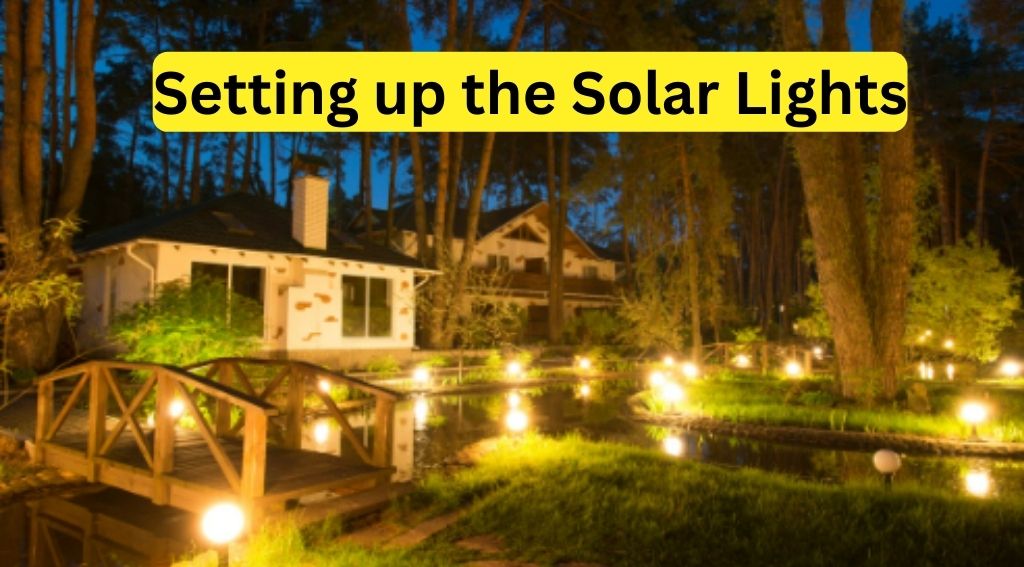
Learn how to hardwire solar lights in simple stages to efficiently install them in your outdoor locations. Solar-powered lighting allows you to save electricity while also providing a well-lit environment.
Installing the solar panels:
- Place the solar panels in a location that receives plenty of sunlight throughout the day.
- Ensure that the panels are set at an angle that maximizes their solar exposure.
- Secure the panels to a strong surface with mounting brackets or screws.
- Check for any shadowing or obstructions that could affect the efficiency of the panels.
- When deciding where to install the panel, consider the direction and angle of the sun.
Battery and Charge Controller Installation:
- Make sure the batteries are fully charged and compatible with the solar lights before attaching them.
- Open the solar lights’ battery compartment and insert the batteries according to the manufacturer’s instructions.
- Connect the batteries’ positive and negative terminals to the appropriate slots in the solar lights.
- Locate the charge controller and attach it to the batteries using the wiring diagrams provided.
- Double-check the connections and secure the battery container to guarantee proper polarity.
Connecting the solar panels to the light fixtures is done as follows:
- Locate the cable coming from the solar panels and connect it to the charge controller’s input terminals.
- Connect the solar panels to the charge controller securely using the necessary wires and connectors.
- Connect the charge controller’s output terminals to the light fixtures, making sure that the polarity is right.
- To prevent inadvertent disconnections, use wire nuts or crimp connectors to secure the connections.
- Before turning on the solar lights, ensure that all connections are tight and well-insulated.
Mounting the panels, installing batteries and charge controllers, and connecting the panels to the light fixtures are all necessary steps in installing solar lighting. Here’s how to do each step correctly:
Installing the solar panels:
- Select a place that receives plenty of sunlight throughout the day and slant the panels to enhance solar absorption.
- Mount the panels using mounting brackets or screws on a sturdy, shade-free surface.
- When mounting the panels, take into account the sun’s direction and angle.
Battery and Charge Controller Installation:
- Before installing the solar lights, ensure that the batteries are fully charged and compatible with them.
- Insert the batteries into the appropriate slots in the light fixtures, paying attention to the polarity.
- Follow the manufacturer’s wiring schematics to connect the batteries to the charge controllers.
- Double-check that the connections are secure and that the battery compartment is correctly closed.
Connecting the light fixtures to the solar panels
- Find the cable coming from the solar panels and connect it to the charge controller’s input terminals.
- Use appropriate cables and connections to ensure a secure connection between the panels and the charge controller.
- Connect the charge controller’s output terminals to the light fixtures while preserving proper polarity.
- To prevent inadvertent disconnections, use wire nuts or crimp connectors to secure the connections.
- Before turning on the solar lights, thoroughly verify all connections to ensure they are secure and insulated.
Connecting the Solar Lights
This comprehensive guide will teach you how to hardwire your solar lights. Learn how to wire your solar lights correctly, step by step, to ensure optimal efficiency and effectiveness.
Understanding Electrical Wiring Components:
- Solar panels: These panels convert sunlight into electrical energy and serve as the primary power source for your solar lighting.
- Batteries: To store the energy that solar panels produce, solar lights require batteries. Rechargeable NiMH or lithium-ion batteries are common types.
- Charge controller: The charge controller, which acts as a regulator, guarantees that the batteries are not overcharged or damaged.
- LED lights: LED lights utilize less energy and are often used in solar lighting systems.
- Wiring: It is required to link all of the components of the solar light system; wiring permits power to flow.
Electrical Circuit Design for Solar Lights:
It is critical to have a clear plan in place before you begin wiring your solar lights. Take a look at the following:
- Identify the place. Choose the locations for the solar lights, ensuring that they receive enough sunlight.
- Determine power requirements: Determine how much power your solar lights will require, taking into account the number of lights and their wattage.
- Select the wiring type: Based on the distance between the solar panel, battery, charge controller, and lighting, select the suitable wiring type.
- Create a wiring diagram: Use a diagram to visualize the entire electrical circuit, noting the location of each component as well as the necessary wiring connections.
Connecting wires and components properly:
Correctly connecting the cables and components is critical for the successful operation of your solar lighting system. Take the following steps:
- Strip the wires: remove the insulation from the wire ends to reveal the conductive cores.
- Connect the solar panels: Connect the positive (+) and negative (-) terminals of the solar panels to the charge controller’s corresponding terminals.
- Connect the batteries: Connect the positive (+) and negative (-) connections of the batteries to the appropriate terminals on the charge controller.
- Connect the charge controller: Connect the charge controller’s load terminals to the positive (+) and negative (-) terminals of the LED lights.
- Secure the connections: To prevent any loose ends, use connectors or screws to secure the wire connections.
- Test the system: Once the wiring is finished, test the solar light system to confirm that all components work properly.
Throughout the installation process, remember to adhere to the manufacturer’s instructions and follow safety guidelines. You may hard-wire your solar light system with an adequate understanding of the wiring components, careful design, and cautious execution.
Wiring Protection and Security
Learn how to hardwire solar lights properly while also ensuring the wiring’s safety and security. Learn about the best techniques for installing and maintaining solar lights for maximum performance.
Providing Adequate Insulation for Outdoor Conditions:
It is critical when hardwiring solar lights to ensure that the wiring is appropriately insulated to withstand outdoor conditions. Here are a few important things to remember:
- Use waterproof connectors: To prevent moisture from entering the wiring system, use connectors that are specifically built for outdoor use
- Select UV-resistant insulation: The sun’s UV rays can cause deterioration and damage to insulation over time. UV-resistant insulation will shield the wiring from any potential damage.
- Wrap the wiring with electrical tape after it has been connected to offer an extra layer of insulation. This will help protect the wiring from the elements.
- Use conduit or sleeves to encase the wire. Install conduit or sleeves to encase the wiring. This will protect it from physical injury as well as weather elements like rain or snow.
Wire Securing for Durability and Aesthetics:
It is critical to secure the wiring appropriately to maintain the endurance and attractiveness of the hardwired solar lights. Consider the following suggestions:
How Well Do Solar Water Fountains Work
- Use cable clips or clamps to secure the wiring. Use cable clips or clamps to secure the wiring. This will keep the wires from dangling and reduce the possibility of inadvertent harm.
- Hide wire with landscaping: To retain a nice and smooth appearance, incorporate the wiring into your landscaping. Bury it in mulch or put it among plants and bushes.
- Conserve wire length: Carefully plan the wiring arrangement to avoid additional wire length. This will not only improve the appearance but will also lessen the possibility of tangling or snagging.
Keeping Potentially Damaged Wiring Safe:
Protecting the wiring from potential damage is critical to ensuring the solar lights’ functioning and lifetime. Here are a few ideas:
- Avoid sharp edges or objects: Make certain that the wiring is routed and installed away from any sharp edges or anything that may cause cuts or abrasion.
- Keep an eye out for rat activity: Take precautions to safeguard the wiring from rodents that may chew on the insulation. Consider installing rodent repellents or sealing any potential entry points.
- Regular inspection and maintenance: Inspect the wiring and lighting regularly for signs of wear or damage. Address any problems as soon as possible to avoid further damage or malfunctions.
You can ensure the long-lasting functionality of your hardwired solar lights while keeping an aesthetically beautiful outdoor lighting arrangement by following these suggestions for protecting and securing the wiring for your hardwired solar lights.
Solar Light Testing and Troubleshooting
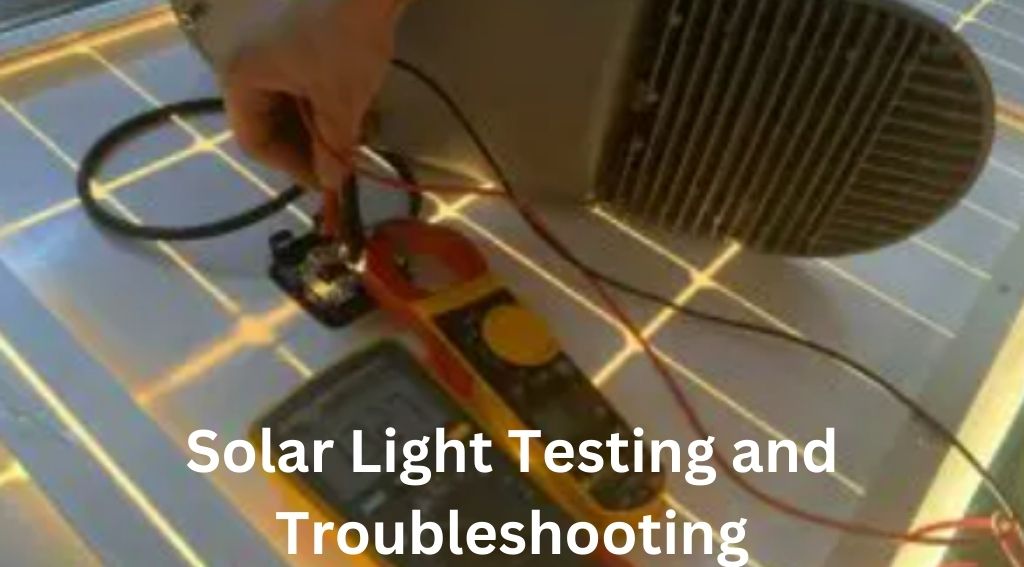
With our complete guide to testing and troubleshooting, you may learn practical strategies for hard-wiring solar lights. This resource will assist you in ensuring optimal performance for your solar light system with step-by-step instructions and handy advice.
Solar lights are an excellent method of lighting your outdoor space while conserving electricity and being environmentally friendly. If you want to hard wire your solar lights for a more permanent installation, make sure they’re working properly and troubleshoot any problems that may emerge.
We’ll walk you through the process of testing and troubleshooting your solar lights to ensure optimal operation in this section.
Testing the operation of solar lights:
Follow these procedures to confirm that your solar lights are working properly before hard wiring them:
- Check for appropriate installation. Ensure that the solar panel is properly positioned and that the lights are firmly mounted.
- To test the solar panel, place your palm over it to block off the light. If the lights turn on, it implies that the solar panel is effectively converting sunlight into power.
- Inspect the battery. Make sure it’s correctly connected and fully charged. You can test the battery by removing it from the solar light and measuring its voltage with a multimeter. A completely charged battery should have a voltage reading that falls within the manufacturer’s range.
- Inspect the LED bulbs. If the solar lights are not turning on, look for evidence of damage or loose connections in the LED bulbs. As needed, replace any faulty bulbs.
Common Problems and Troubleshooting Suggestions:
Solar lights may occasionally experience problems that prevent them from working properly. The most frequently encountered issues and how to fix them are as follows:
For optimum performance, regular maintenance is required.
Regular maintenance is required to keep your hard-wired solar lights operating at peak performance. Here are some suggestions for upkeep:
- Clean the solar panel regularly to eliminate dust, grime, and debris. A dirty panel can prevent sunlight from being converted into power, reducing the performance of your solar lighting.
- Inspect for damage: Inspect the solar lights regularly for signs of damage, such as cracked casings or loose connections. Make sure any broken parts are fixed or replaced right away.
- Replace batteries as needed: Solar light batteries might lose their ability to hold a charge over time. Consider replacing the batteries if you notice a considerable decline in performance.
You can ensure that your hard-wired solar lights provide reliable and efficient lighting for years to come by following these testing and troubleshooting suggestions and performing regular maintenance.
Including Hard Wiring in an Existing Lighting System
Hardwire solar lights into an existing lighting system for improved functionality and efficiency. Learn how to connect and power solar lights without the use of batteries or other external power sources.
Using Solar Lights in Traditional Lighting:
How to Hard Wire Solar Lights are a low-cost and environmentally friendly solution to lighting your outdoor space. You may build a seamless combination of solar and conventional power sources by connecting hard wiring with existing lighting systems. This section will walk you through the steps of installing solar lights into your existing lighting setup, adapting existing fixtures for hard wiring, and even combining solar and traditional power sources for maximum efficiency.
Installing hard wiring in existing fixtures:
There are a few critical procedures to take when upgrading old fixtures for hard wiring:
- Assess your fixtures. Begin by evaluating the condition and suitability of your current fixtures for hard wiring. Look for fixtures that are strong, in good shape, and compatible with the solar lights you want to use.
- Disconnect power: To safeguard your safety, switch off the power to the lighting circuit at the breaker box before beginning any electrical work. Always use a voltage tester to double-check that the power is turned off.
- Remove obsolete components: Remove any obsolete bulbs, wiring, or other components. This will clear the way for the installation of your new solar lights.
- Prepare for hard wiring: If your existing fixtures have a power supply nearby, you can hard wire your solar lights into that power source. If not, new electrical cabling may be required to connect the solar lights to the power source.
- Install solar light components: Install the solar light components, which normally include the solar panel, battery, and LED light bulb, according to the manufacturer’s instructions. Attach the solar panel securely in an area that receives plenty of sunshine.
- Connect the wiring: Follow electrical safety requirements when connecting the cabling from the solar lights to the power source. Assure a secure connection and, if necessary, shield the wiring with a conduit.
- Test and adjust: Once the hard wiring is complete, test the solar lights to confirm they are working properly. Adjust the location of the solar panel and light bulb as needed to maximize sunshine exposure and illumination.
Combining Solar and Traditional Energy Sources:
Combining solar and traditional power sources gives your outdoor lighting design versatility and dependability. Here’s how to strike this balance:
- Hybrid lighting systems: Think about installing a hybrid lighting system that blends solar and traditional electricity sources. This configuration offers continuous illumination, even during periods of low sunshine or power interruptions.
- Smart controls: Integrate smart controls into your lighting system to switch between solar and conventional power sources based on parameters such as available sunshine or time of day. This improvement reduces energy usage and assures smooth functioning.
- Battery backup: Include battery backup devices to store extra solar energy throughout the day for usage at night or on overcast days. When solar power is limited, this backup power source offers consistent lighting.
- Expert assistance: If integrating solar and traditional electricity sources appears complicated or daunting, consider hiring an expert. A skilled electrician or solar installer can assist you in designing and implementing a hybrid lighting system that is tailored to your requirements.
You can construct an efficient, cost-effective, and environmentally responsible outdoor lighting setup by seamlessly integrating solar lights into your standard lighting system, adapting existing fixtures for hard wiring, and combining solar and conventional power sources. Take advantage of solar power’s versatility and sustainability while maintaining the dependability of your existing lighting system.
Increasing the Range of Solar Lighting
Do you want to extend the range of your solar lighting? Discover how to hard-wire solar lights for more usefulness and convenience. Reduce your reliance on standard electrical lights by easily illuminating your outside environment.
Because of their energy efficiency and ease of installation, solar lights are a fantastic alternative for illuminating outdoor spaces. However, there may be times when you need to extend the reach of solar illumination beyond its initial design constraints. There are options for brightening rural places, improving the illumination of larger spaces, and scaling up your solar lighting system.
Extending Solar Lights to More Remote Locations:
There are a few factors to consider while using solar electricity to illuminate rural regions. Here are some ideas for extending the range of solar lighting:
- Use longer-cabled solar panels. If the cable provided with your solar lights is insufficient to reach remote places, try installing solar panels with longer cables. This allows you to place the panel in a more sunny location and connect it to your lights in a more distant location.
- Use solar light extensions: Some manufacturers sell solar light extensions made expressly to extend the reach of your solar lights. These extensions include additional cords, allowing you to position your lights further away from the panel.
- Add more solar panels: If the distance between your solar panel and the remote region is too great, you can add more solar panels near your lights. This allows you to more effectively distribute solar electricity and ensure adequate illumination.
Improving the Illumination of Larger Areas
Solar lights are frequently used to light up small outdoor spaces, such as gardens or walks. However, if you have a larger room that requires lighting, here are some suggestions:
- Make use of solar floodlights. Solar floodlights are intended to produce brilliant, wide-angle illumination. These lights can efficiently cover larger areas and provide appropriate brightness in vast settings.
- Consider solar spotlights: In bigger rooms, solar spotlights are perfect for spotlighting specific features or places of interest. You can create an impressive lighting design while conserving energy by directing the light towards key areas.
- Deliberately combine multiple solar lights: Another alternative for illuminating larger areas is to deliberately combine numerous ordinary solar lights. You may produce uniform illumination across the entire area by arranging them in a grid-like arrangement.
Solar Lighting System Expansion:
Here are a few pointers to consider if you want to expand your solar lighting system to meet larger lighting requirements:
- Determine your energy needs: Determine the amount of lighting you require and estimate your total energy consumption. This will assist you in selecting a solar panel with enough capacity to meet the increased demand.
- Install a larger battery: Consider upgrading to a larger battery that can store more solar energy for later usage to ensure extended illumination during longer nights or cloudier days.
- Increase the number of lights in your system to equally spread illumination across the specified region. This will eliminate dark patches and maintain uniform lighting throughout.
Keep in mind that by following these tactics, you can extend the reach of solar lighting to remote places, improve illumination in larger spaces, or scale up your solar lighting system. Investigate the options that best meet your requirements and take advantage of solar-powered lighting solutions.
Increasing energy efficiency
Learn how to hard-wire solar lights to increase their energy efficiency. This simple procedure will assist you in conserving energy and lowering your carbon footprint.
Optimizing the Orientation of Solar Panels for Maximum Sunlight:
- Place the solar panel in a location that receives direct sunlight throughout the day.
- For optimal sun exposure, ensure that the panel faces true south (in the Northern Hemisphere) or true north (in the Southern Hemisphere).
- Tilt the solar panel at an angle that corresponds to your location’s latitude for optimum energy capture.
- Avoid being in the shade of nearby trees, buildings, or other objects that might hinder the absorption of sunlight.
Changing the Capacity and Charging Parameters:
- Choose a battery with enough capacity to store the energy the solar panel produces.
- Maintain the battery’s health and efficiency by monitoring its voltage levels and charging parameters.
- Adjust the charging parameters, such as voltage and current, to match the manufacturer’s specifications.
- Make sure the battery is completely charged before going to bed to ensure that the solar lights have enough juice.
Making Use of Energy-Saving Features and Timers:
- Reduce energy consumption by utilizing energy-saving features such as motion sensors or dimming capabilities.
- Use timers to set certain working hours for your solar lights, allowing them to switch on and off at predetermined intervals.
- Choose LED solar lights, which are more energy-efficient and can provide adequate lighting while using less power.
- Check and maintain energy-saving features and timers regularly to maximize their performance.
Remember that maximizing energy efficiency in your hardwired solar light setup entails more than just installing the components. You may improve the performance and sustainability of your solar lighting system by optimizing solar panel orientation, modifying battery capacity and charging parameters, and utilizing energy-saving features and timers.
Using Smart Technology to Improve Control?
Learn How to Hard Wire Solar Lights and include smart technologies for efficient and convenient operation to have more control over your outdoor lighting. With three simple steps, you can take complete control of your solar lighting system.
Solar lighting has grown in popularity as an eco-friendly and cost-effective option for outdoor illumination. You can, however, take your solar lights to the next level by including smart technology. You can improve the control and convenience of your solar lights by using automation and remote control options.
In this section, we will look at how to integrate smart technology into your solar lighting system so that you can monitor and regulate your lights from your smartphone.
Automation and remote control functions are now available.
- Improved Control: By adding automation and remote control functions, you can effortlessly manage and control your solar lights with a few smartphone touches. This lets you turn on and off your lights, alter their brightness levels, and even create timers or schedules for when they should turn on and off.
- Convenience at Your Fingertips: You can effortlessly operate your solar lights from the comfort of your own home with remote control features. Whether you want to turn on the lights as you walk in the door or turn them off without leaving the house, smart technology provides convenience and ease of use.
- Energy Efficiency: Automation features allow you to optimize your solar lights’ energy use. For example, you can design your lights to dim or switch off automatically during daylight hours, conserving energy and increasing the effectiveness of your solar lighting system.
Solar Lighting Integration with Smart Home Systems:
- Easy Integration: By connecting your solar lights to a smart home system like Google Home or Amazon Alexa, you can manage them with voice commands. With this connection, you can easily manage your lights while engaging with your smart home devices.
- Sync with Other Smart Devices: By incorporating solar lighting into your smart home system, you can synchronize your lights with other smart devices, such as motion sensors or security cameras. This synergy improves the overall functioning and effectiveness of your smart home ecosystem.
- Customization: By integrating smart home devices, you may tailor your solar lighting experience to your specific needs. The options for customizing are unlimited, whether you want your lights to turn on automatically when you enter a specific zone or to create a unique lighting scene for special events.
Using a Smartphone to Monitor and Manage Solar Lights:
- Real-time Monitoring: You can check the operation of your solar lights in real time using specific smartphone apps, thanks to smart technology. This function allows you to check battery levels, assess energy consumption, and receive information about any repair needs.
- Remote Troubleshooting: If your solar lights malfunction, you may easily troubleshoot them remotely using your smartphone. The apps provide thorough diagnostics and troubleshooting guidelines to assist you in swiftly and efficiently resolving any issues.
- Data Insights: Smart technology provides you with useful data and insights into your solar lighting system. You can gain access to information such as energy usage patterns, historical performance data, and even lighting optimization recommendations. This data-driven method enables you to make informed decisions while increasing the effectiveness of your solar lighting.
You may improve control, convenience, and energy efficiency by introducing smart technologies into your solar lighting system. You can take your solar lights to the next level with automation and remote control functions, seamless interaction with smart home systems, and the ability to monitor and manage your lights from a smartphone.
Upgrade your outdoor lighting experience and harness the power of smart technology to create a brighter and smarter future.
Displaying Solar Lighting in a Variety of Applications?
Discover Hard Wire Solar Lights can be used in a variety of situations. Learn how to hard-wire solar lights for easy installation and energy efficiency. Eco-friendly and cost-effective lighting solutions will illuminate your space.
Pathway and walkway lighting:
Solar lights are a fantastic alternative for illuminating paths and sidewalks since they are both useful and aesthetically pleasing. How to Hard Wire Solar Lights
They are simple to install and do not require intricate wiring or digging trenches, making them an easy alternative for lighting up your outside space. The following are some significant advantages to employing solar lights to improve your paths and walkways:
- Low-cost: Solar lights use the sun’s renewable energy to illuminate your path while saving you money on electricity.
- Simple installation: Because solar lights run independently, no electrical connections are necessary. Simply position them along your route or walkway in suitable areas.
- Electricity efficiency: Solar lights use the power of the sun throughout the day and switch on automatically in the dark, conserving electricity and eliminating unwanted light pollution.
- Visibility and safety: Well-lit paths and walkways improve visibility and safety during evening walks or when guests visit your property.
- Versatility: Solar lights are available in a variety of patterns and styles, allowing you to select solutions that complement your outdoor décor.
Lighting Up Outdoor Gardens and Landscapes:
- Solar lights can also be used to liven up outside landscapes and gardens, giving your outdoor environments a wonderful touch.
- Solar lights, with their unique and elegant designs, are not only functional but also add to the overall appeal of your outdoor areas.
- The following are some significant benefits of employing solar lights in your outside landscapes and gardens:
- Environmentally friendly: Because they use solar energy, these lights help reduce carbon emissions and your environmental impact.
- Flexibility: Because solar lights are not constrained by electricity outlets, you may install them wherever you choose, whether it’s illuminating a flower bed, spotlighting a tree, or along a garden path.
- Low upkeep: Because solar lights are self-sufficient, they require little maintenance. To ensure maximum efficiency, all you need to do is clean the solar panels regularly.
- Customization: Solar lights are available in a variety of colors, designs, and sizes, allowing you to create a one-of-a-kind ambiance in your outdoor settings. The possibilities are boundless, from playful string lights to beautiful lanterns.
- Energy savings: Using solar lighting in your outside landscaping and gardens will help you save money in the long run.
Using Solar Lights to Improve Security and Safety:
Solar lights can also help to improve security and safety around your property, giving you peace of mind while adding an extra layer of protection. The following are some significant advantages to employing solar lights for security and safety:
- Motion-sensing technology: Many solar lights include built-in motion sensors that turn on the lights when they detect movement. This technology keeps intruders at bay while also alerting residents to potential risks.
- Illuminated entryways: Installing solar lights at entrances, gates, or garages guarantees that pathways are well-lit, lowering the chance of accidents and repelling unwelcome attention.
- Emergency lighting: In the case of a power outage or an emergency, solar lights can provide a dependable source of illumination, allowing you to safely manage your property.
- Automated operation: Solar lights switch on at nightfall and off at dawn, removing the need for manual control and maintaining continuous lighting throughout the night.
- Convenient installation: Whether you need to illuminate a dark driveway, backyard, or outdoor storage area, solar lights provide a flexible and effective option that eliminates the need for wiring.
You may transform your outside environment into a well-lit and visually appealing sanctuary by incorporating solar lights into numerous applications, such as illuminating roads and walkways, lighting up outdoor landscapes and gardens, and improving security and safety. Choose solar lights that complement your decor while providing the benefits of sustainability and energy efficiency.
Solar Lighting: Inspiring Sustainable Living
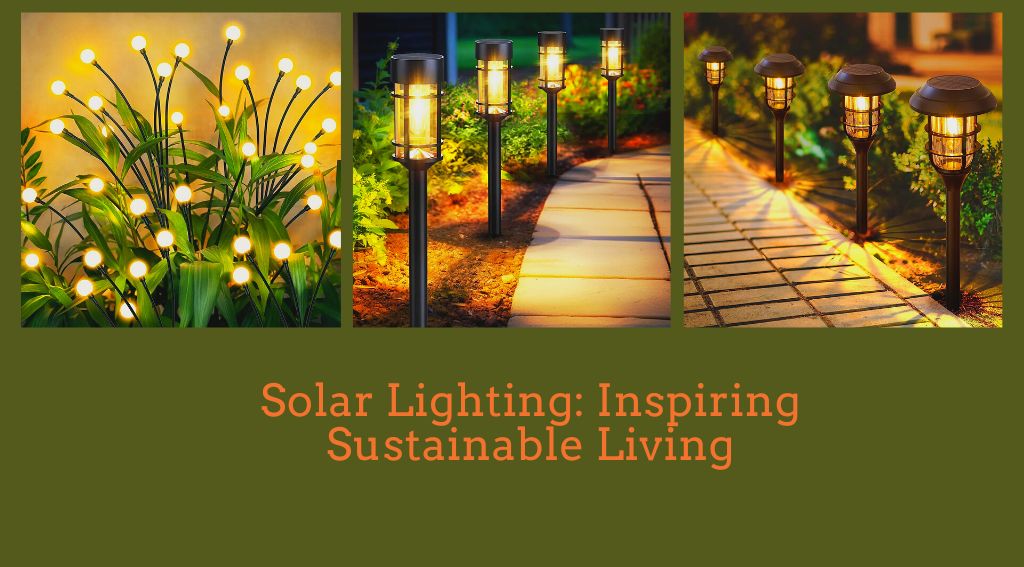
Hardwired solar lights may transform your outdoor space into an eco-friendly haven. Learn how to use the sun’s energy to create sustainable lighting that lights your surroundings while lowering your carbon footprint. How to Hard Wire Solar Lights
Solar illumination has become a popular and environmentally beneficial alternative to standard lighting methods. These lights provide several benefits by capturing the power of the sun and are quickly gaining favor among ecologically aware consumers. This section will investigate the environmental benefits of solar illumination, as well as its energy independence and resource efficiency, as well as its potential for raising awareness and encouraging wider adoption. What is a Solar Battery
Solar lighting has a low environmental impact.
- Solar illumination uses renewable energy, which reduces reliance on fossil fuels and greenhouse gas emissions.
- When compared to traditional lighting choices, the creation of solar lights uses fewer materials and chemicals, resulting in a lower carbon impact.
- Individuals who use solar lights help to reduce light pollution and maintain the natural habitats of numerous species.
Promoting resource efficiency and energy independence:
- Solar lighting is a potential off-grid lighting alternative, allowing people to have access to lighting even in distant places where there is no electrical infrastructure.
- Solar lights provide energy independence and lessen reliance on the power grid due to their self-sustaining functioning.
- Solar lights maximize resource efficiency and minimize waste by charging during the day and illuminating at night.
Raising awareness and promoting adoption
- Solar illumination provides an opportunity to teach others about the advantages of clean energy and living sustainably.
- As more people use solar illumination, the increased demand will spur innovation and lower costs, making it more accessible to a wider range of people.
- Community initiatives, awareness campaigns, and instructional programs can all help inspire others to use solar lighting.
Solar lighting can change the way we brighten our surroundings while also having a positive impact on the environment. Solar lighting is a sustainable and eco-friendly lighting solution since it reduces our carbon footprint, promotes energy independence, and raises awareness. Adopting solar illumination benefits not only the environment but also contributes to a greener and more sustainable future for all.
Frequently Asked Questions: How To Hard Wire Solar Lights
Is it possible to hard-wire solar lights?
Yes, you may hard-wire solar lights to ensure a consistent and steady power source.
How are solar lights connected?
Solar lights are wired by forming a circuit with the solar panels, battery, and light source.
Is it possible to convert battery-powered lights to solar?
Yes, battery-powered lighting can be switched to solar power for increased energy efficiency and sustainability.
Can you connect solar lights?
Yes, you can connect solar lights to improve their energy production.
How Do You Install Solar Lights?
To hard-wire solar lights, first find an appropriate power source, then strip the wires, connect them to the power source, and then secure the connections with wire nuts or electrical tape.
Conclusion
Hard Wire Solar Lights, an eco-friendly, and cost-effective alternative to typical lighting fixtures. You can fully harness the power of the sun to illuminate your home by learning how to hard-wire solar lights. You can ensure a smooth installation process by taking basic measures like selecting the correct place, fastening the panel and batteries, and connecting the circuit.
Remember to take safety precautions and, if necessary, seek the advice of a specialist. Once installed, you may enjoy worry-free lights powered by renewable energy. Solar lights not only help to minimize your carbon footprint, but they also help you save money on your electricity costs.
So embrace the power of the sun today by hardwiring your solar lights and reaping the benefits of sustainable and efficient outdoor lighting.


